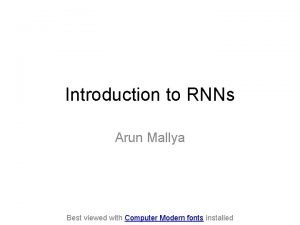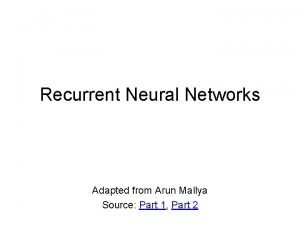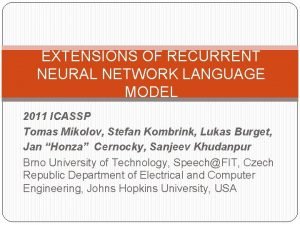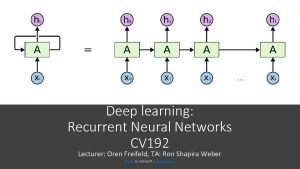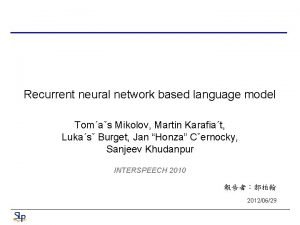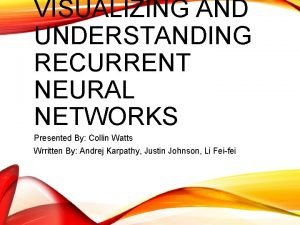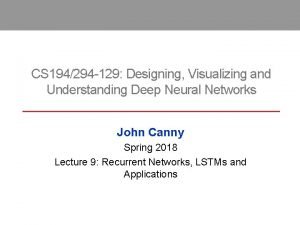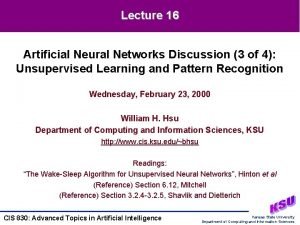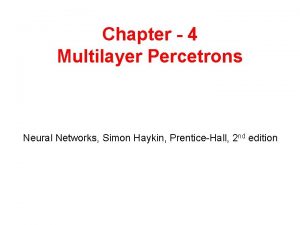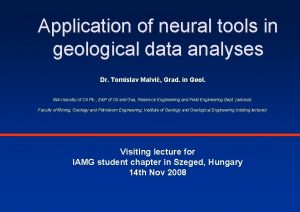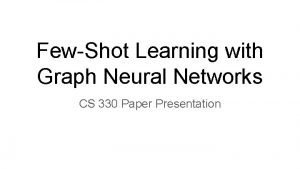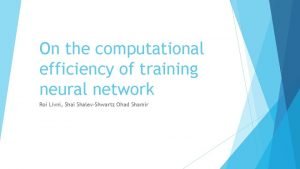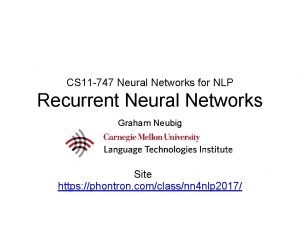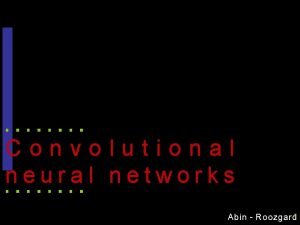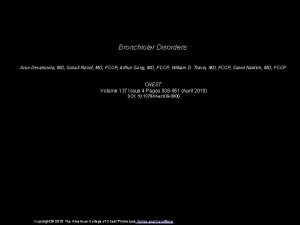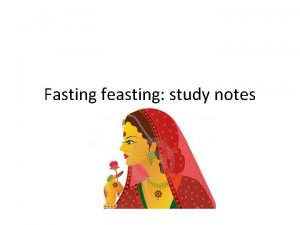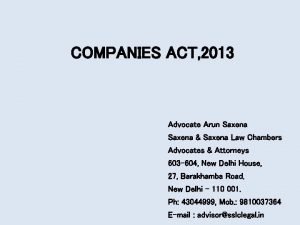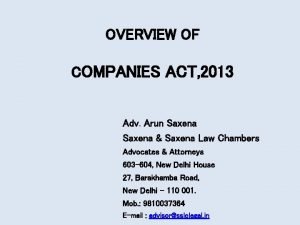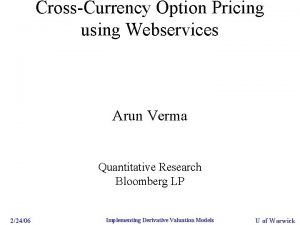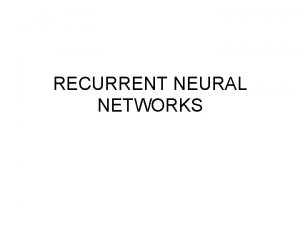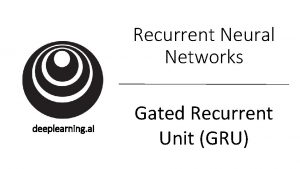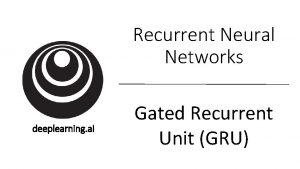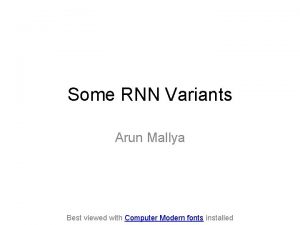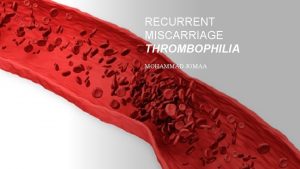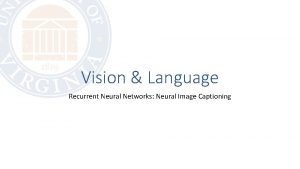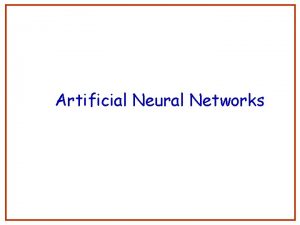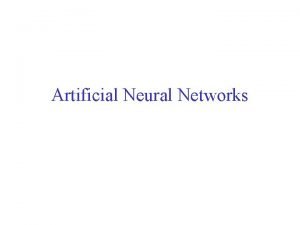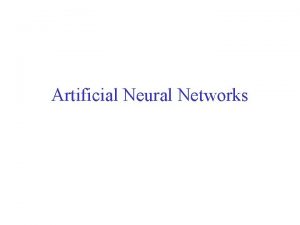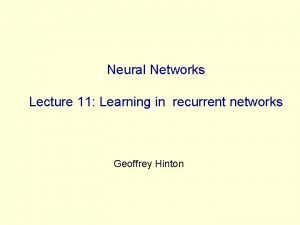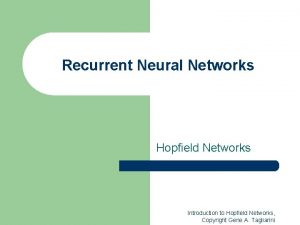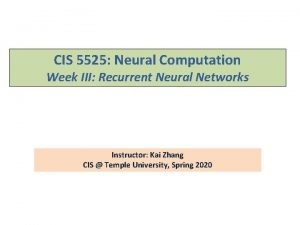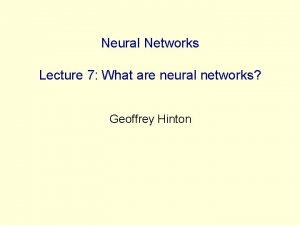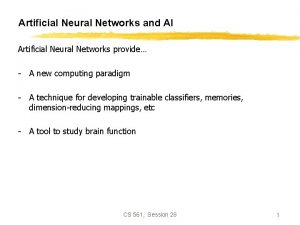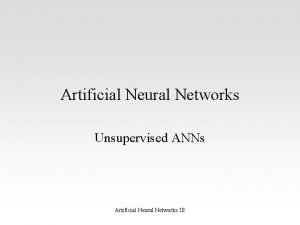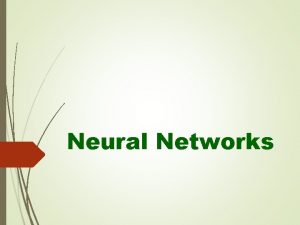Recurrent Neural Networks Adapted from Arun Mallya Source





















































- Slides: 53

Recurrent Neural Networks Adapted from Arun Mallya Source: Part 1, Part 2

Outline • Sequential prediction problems • Vanilla RNN unit – Forward and backward pass – Back-propagation through time (BPTT) • Long Short-Term Memory (LSTM) unit • Gated Recurrent Unit (GRU) • Applications

Sequential prediction tasks • So far, we focused mainly on prediction problems with fixed-size inputs and outputs • But what if the input and/or output is a variable-length sequence?

Text classification • Sentiment classification: classify a restaurant or movie or product review as positive or negative – “The food was really good” – “The vacuum cleaner broke within two weeks” – “The movie had slow parts, but overall was worth watching” • What feature representation or predictor structure can we use for this problem?

Sentiment classification • “The food was really good” Classifier Hidden state “Memory” “Context” h 5 h 1 “The” h 2 “food” h 4 h 3 “was” “really” Recurrent Neural Network (RNN) “good”

Language Modeling

Language Modeling • Character RNN Image source

Character RNN Output symbol yi Output layer (linear transformation + softmax) Hidden state hi One-hot encoding xi Input symbol Image source

Character RNN • Generating paint colors http: //aiweirdness. com/post/160776374467/new-paintcolors-invented-by-neural-network

Image Caption Generation • Given an image, produce a sentence describing its contents “The dog is hiding”

Image Caption Generation “The” “dog” “is” “hiding” “STOP” Classifie r Classifie r h 1 h 0 CNN “START” “dog” h 5 h 4 h 3 h 2 “The” h 4 h 3 h 2 “is” “hiding”

Machine translation https: //translate. google. com/

Machine translation • Multiple input – multiple output (or sequence to sequence) “Matches” “Correspondances”“La” “nature” “Nature” “is”

Summary: Input-output scenarios Single - Single Feed-forward Network Multiple - Single Sequence Classification Single - Multiple Image Captioning Multiple - Multiple Translation

Recurrent Neural Network (RNN) Output at time t Hidden representation at time t yt Classifier ht Hidden layer Input at time t xt new state function input at of W time t old state

Unrolling the RNN y 3 y 2 Classifier y 1 h 3 Classifier h 2 Classifier h 1 Hidden layer h 0 x 1 t=1 h 1 Hidden layer x 2 t=2 h 2 Hidden layer x 3 t=3 h 3

Vanilla RNN Cell ht W ht-1 xt J. Elman, Finding structure in time, Cognitive science 14(2), pp. 179– 211, 1990

Vanilla RNN Cell ht W xt ht-1 Image source

Vanilla RNN Cell ht W ht-1 xt Image source

Vanilla RNN Cell ht W ht-1 xt m n-dim. m-dim.

RNN Forward Pass h 0 e 1 e 2 e 3 y 1 y 2 y 3 h 1 h 2 h 3 x 1 h 1 x 2 h 2 x 3 shared weights

Backpropagation Through Time (BPTT) • Most common method used to train RNNs • The unfolded network (used during forward pass) is treated as one big feed-forward network that accepts the whole time series as input • The weight updates are computed for each copy in the unfolded network, then summed (or averaged) and applied to the RNN weights

Unfolded RNN Forward Pass h 0 e 1 e 2 e 3 y 1 y 2 y 3 h 1 h 2 h 3 x 1 h 1 x 2 h 2 x 3

Unfolded RNN Backward Pass h 0 e 1 e 2 e 3 y 1 y 2 y 3 h 1 h 2 h 3 x 1 h 1 x 2 h 2 x 3

Backpropagation Through Time (BPTT) • https: //machinelearningmastery. com/gentle-introduction-backpropagation-time/ http: //www. cs. utoronto. ca/~ilya/pubs/ilya_sutskever_phd_thesis. pdf

RNN Backward Pass Error from yt Error from predictions at future steps ht W ht-1 Propagate to earlier time steps xt

RNN Backward Pass e 1 e 2 e 3 y 1 y 2 y 3 h 1 h 0 h 2 x 1 h 1 Large tanh activations will give small gradients h 3 x 2 h 2 x 3

RNN Backward Pass h 0 e 1 e 2 e 3 y 1 y 2 y 3 h 1 h 2 h 3 x 1 h 1 x 2 h 2 x 3

Long Short-Term Memory (LSTM) • Add a memory cell that is not subject to matrix multiplication or squishing, thereby avoiding gradient decay xt ht-1 ht ct-1 ct S. Hochreiter and J. Schmidhuber, Long short-term memory, Neural Computation 9 (8), pp. 1735– 1780, 19

The LSTM Cell xt ht-1 Wg Cell ct ht * Dashed line indicates time-lag

The LSTM Cell xt ht-1 Wg Cell ct ht

The LSTM Cell xt Input Gate ht-1 Wi it xt ht-1 Wg . Cell ct ht

The LSTM Cell xt Input Gate ht-1 xt Wi it Output Gate ht-1 Wg . ot Wo xt ht-1 Cell . ct ht

The LSTM Cell xt Input Gate ht-1 xt Wi it Output Gate ht-1 Wg ot Wo xt ht-1 Cell . . ct Forget Gate ft Wf xt ht-1 ht

LSTM Forward Pass Summary • Figure source

LSTM Backward Pass • For complete details: Illustrated LSTM Forward and Backward Pass Figure source

Gated Recurrent Unit (GRU) xt Update Gate xt W . ht-1 Wf xt rt Reset Gate h’t ht-1 zt Wz • Get rid of separate cell state ht • Merge “forget” and “output” gates into “update” gate ht-1 K. Cho, B. Van Merrienboer, C. Gulcehre, D. Bahdanau, F. Bougares, H. Schwenk, and Y. Bengio, Learning phrase representations using RNN encoder-decoder for statistical machine translation, ACL

Gated Recurrent Unit (GRU) xt ht-1 W ht

Gated Recurrent Unit (GRU) xt W . ht-1 Wf xt rt Reset Gate ht-1 h’t

Gated Recurrent Unit (GRU) xt Update Gate xt W . ht-1 Wf xt rt h’t ht-1 zt Wz Reset Gate ht-1

Gated Recurrent Unit (GRU) xt Update Gate xt W . ht-1 Wf xt rt h’t ht-1 zt Wz ht Reset Gate ht-1

Multi-layer RNNs • We can of course design RNNs with multiple hidden layers y 1 y 4 y 2 y 3 y 5 y 6 x 1 x 2 x 3 x 4 x 5 x 6 • Anything goes: skip connections across layers, across time, …

Bi-directional RNNs • RNNs can process the input sequence in forward and in the reverse direction y 1 y 2 y 3 y 4 y 5 y 6 x 1 x 2 x 3 x 4 x 5 x 6 • Popular in speech recognition

Use Cases Multiple input – Single output Sequence Classification Single - Multiple Image Captioning Multiple - Multiple Translation

Sequence Classification Linear Classifier Ignore h 1 h 2 hn RNN RNN The h 1 food h 2 hn-1 good

Sequence Classification Linear Classifier h = Sum(…) h 1 RNN The h 1 hn h 2 RNN h 2 food http: //deeplearning. net/tutorial/lstm. html hn-1 RNN good

Sequence Classification Linear Classifier h = Sum(…) h 1 Bi-RNN The h 1 hn h 2 Bi-RNN food h 2 hn-1 Bi-RNN good

Character RNN 100 th iteratio n 300 th iteration 700 th iteration 2000 th iteratio n http: //karpathy. github. io/2015/05/21/rnn-effectiveness/ Image source

Image Caption Generation “The” “dog” “is” “hiding” “STOP” Classifie r Classifie r h 1 h 0 CNN “START” “dog” h 5 h 4 h 3 h 2 “The” h 4 h 3 h 2 “is” “hiding”

Image Caption Generation O. Vinyals, A. Toshev, S. Bengio, D. Erhan, Show and Tell: A Neural Image Caption Generator, CVPR 2015

Image Caption Generation

Machine Translation Sequence-to-sequence I. Sutskever, O. Vinyals, Q. Le, Sequence to Sequence Learning with Neural Networks, NIPS 2014 Encoder-decoder K. Cho, B. Merrienboer, C. Gulcehre, F. Bougares, H. Schwenk, and Y. Bengio, Learning phrase representations using RNN encoder-decoder for statistical machine translation, ACL 2014

Useful Resources / References • • http: //cs 231 n. stanford. edu/slides/winter 1516_lecture 10. pdf http: //www. cs. toronto. edu/~rgrosse/csc 321/lec 10. pdf • R. Pascanu, T. Mikolov, and Y. Bengio, On the difficulty of training recurrent neural networks, ICML 2013 S. Hochreiter, and J. Schmidhuber, Long short-term memory, Neural computation, 1997 9(8), pp. 1735 -1780 F. A. Gers, and J. Schmidhuber, Recurrent nets that time and count, IJCNN 2000 K. Greff , R. K. Srivastava, J. Koutník, B. R. Steunebrink, and J. Schmidhuber, LSTM: A search space odyssey, IEEE transactions on neural networks and learning systems, 2016 K. Cho, B. Van Merrienboer, C. Gulcehre, D. Bahdanau, F. Bougares, H. Schwenk, and Y. Bengio, Learning phrase representations using RNN encoder-decoder for statistical machine translation, ACL 2014 R. Jozefowicz, W. Zaremba, and I. Sutskever, An empirical exploration of recurrent network architectures, JMLR 2015 • • •
 Arun mallya
Arun mallya Translate.google.com
Translate.google.com Rnn
Rnn Andrew ng rnn
Andrew ng rnn Extensions of recurrent neural network language model
Extensions of recurrent neural network language model Lstm colah
Lstm colah Recurrent neural network based language model
Recurrent neural network based language model Visualizing and understanding recurrent networks
Visualizing and understanding recurrent networks Coco
Coco Satish mallya
Satish mallya Convolutional neural networks for visual recognition
Convolutional neural networks for visual recognition Threshold logic unit in neural network
Threshold logic unit in neural network The wake-sleep algorithm for unsupervised neural networks
The wake-sleep algorithm for unsupervised neural networks Neural networks and learning machines 3rd edition
Neural networks and learning machines 3rd edition Vc dimension neural network
Vc dimension neural network Xor problem
Xor problem Neuraltools neural networks
Neuraltools neural networks Efficient processing of deep neural networks pdf
Efficient processing of deep neural networks pdf Neural networks and fuzzy logic
Neural networks and fuzzy logic Audio super resolution
Audio super resolution Introduction to neural networks using matlab
Introduction to neural networks using matlab Few shot learning with graph neural networks
Few shot learning with graph neural networks Neural networks ib psychology
Neural networks ib psychology Csrmm
Csrmm Predicting nba games using neural networks
Predicting nba games using neural networks Mippers
Mippers Xooutput
Xooutput Convolutional neural network alternatives
Convolutional neural network alternatives Neural networks for rf and microwave design
Neural networks for rf and microwave design Deep forest: towards an alternative to deep neural networks
Deep forest: towards an alternative to deep neural networks Audio super resolution using neural networks
Audio super resolution using neural networks On the computational efficiency of training neural networks
On the computational efficiency of training neural networks Neural networks and learning machines
Neural networks and learning machines Introduction to convolutional neural networks ppt
Introduction to convolutional neural networks ppt Visualizing and understanding convolutional networks
Visualizing and understanding convolutional networks Lmu cis
Lmu cis 11-747 neural networks for nlp
11-747 neural networks for nlp Leon gatys
Leon gatys Convolutional neural networks
Convolutional neural networks Backbone networks in computer networks
Backbone networks in computer networks Virtual circuits and datagram networks
Virtual circuits and datagram networks Arun khan
Arun khan Arun zurel
Arun zurel Arun saini md
Arun saini md Devakonda
Devakonda Jobtracker
Jobtracker Spirit of performance koenigsegg
Spirit of performance koenigsegg Arun kaura
Arun kaura Fasting feasting summary
Fasting feasting summary Saxena and saxena law chambers
Saxena and saxena law chambers Arun sambataro
Arun sambataro Arun saxena advocate
Arun saxena advocate Arun verma bloomberg
Arun verma bloomberg Dr arun shahi
Dr arun shahi
